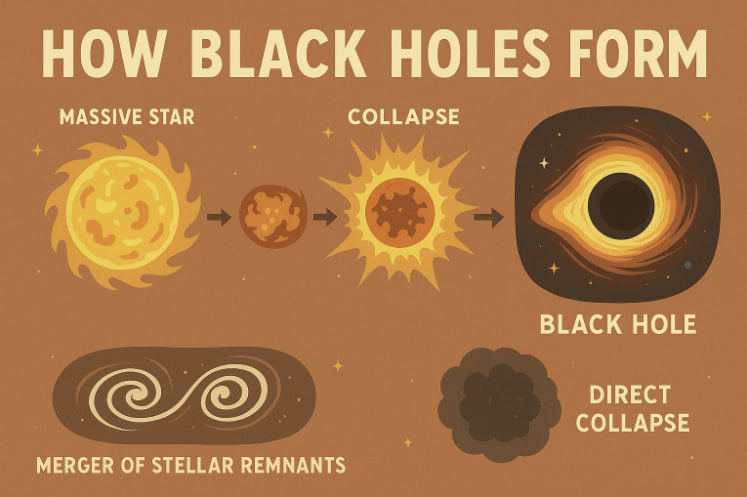Black holes are not cosmic voids—they are the ultra-dense, incredibly powerful remnants of matter compressed to extreme limits. Despite their fearsome reputation, black holes form naturally from processes we can observe and understand through physics. Their formation marks the violent end of some stars, and in some cases, the mysterious collapse of early-universe structures.
Let’s explore how black holes come into existence and the conditions that lead to their creation.
1. Stellar Collapse: The Most Common Path
Most known black holes form when massive stars exhaust their nuclear fuel.
Step-by-step process:
- Nuclear fusion ends: A star fuses hydrogen into helium for millions of years. Eventually, even heavier elements (like iron) build up in the core.
- Core collapse: Fusion can no longer support the star’s gravity. The core collapses in a fraction of a second.
- Supernova explosion: Outer layers of the star explode outward in a dramatic blast.
- Remnant fate:
- If the core is 1.4–3 solar masses, it becomes a neutron star.
- If the core is more than ~3 solar masses, gravity overwhelms all resistance and forms a black hole.
This is how stellar-mass black holes (5–100 times the Sun’s mass) are born.
2. Mergers of Stellar Remnants
Two neutron stars—or a neutron star and a black hole—can merge through the emission of gravitational waves.
- This collision forms a larger black hole and produces a burst of radiation (kilonova).
- Such events have been observed by LIGO and Virgo, confirming how black holes can grow from cosmic violence.
3. Direct Collapse in the Early Universe
In the early universe, before stars and galaxies fully formed, regions of dense gas may have collapsed directly into black holes without forming stars first.
- These are called direct-collapse black holes.
- This process might explain the existence of supermassive black holes seen only a few hundred million years after the Big Bang.
4. Growth Into Supermassive Black Holes
Found at the centers of galaxies, supermassive black holes (millions to billions of solar masses) likely formed by:
- Repeated mergers of black holes
- Accreting massive amounts of gas and dust
- Feeding on stars and cosmic debris over billions of years
The exact origin of their early growth remains one of the biggest mysteries in astrophysics.
5. Primordial Black Holes (Hypothetical)
Some theories suggest that tiny black holes may have formed from density fluctuations in the early universe.
- These primordial black holes could range in size from subatomic to planetary mass.
- They might explain dark matter, but no evidence has confirmed their existence yet.
Glossary
- Supernova — A massive explosion marking the end of a star’s life.
- Core collapse — The implosion of a star’s core under gravity.
- Neutron star — A dense stellar remnant composed mostly of neutrons.
- Accretion — The gradual accumulation of matter by gravitational pull.
- Gravitational waves — Ripples in space-time caused by massive, accelerating objects.


